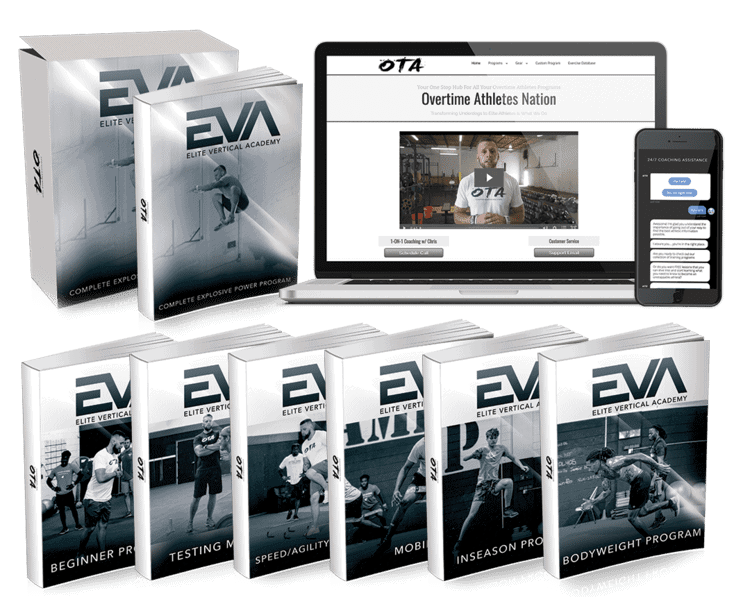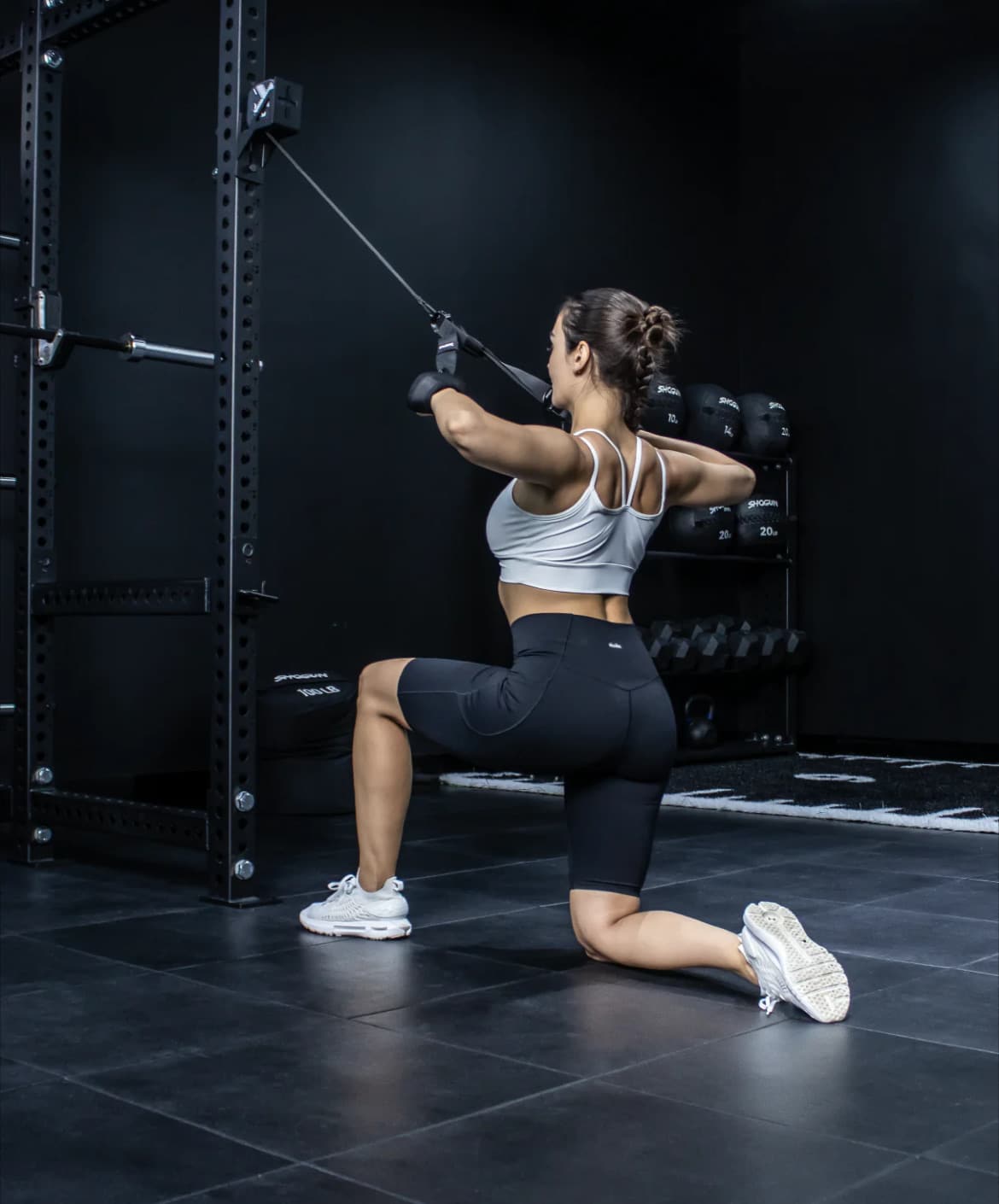Over the past few months I’ve purchased and dissected every single vertical jump program on the market…
Of the hundreds of exercises I analyzed, certain movements continued popping up over and over again, across many of the programs.
Why?
Because they’re super effective at getting results.
This article uncovers the absolute best exercises to increase your vertical jump in 2024, based upon the recommendations of the world’s top vertical jump coaches.
Some of them are timeless classics and others are relatively new and less well-known, but still extremely powerful.
I’ve selected what I believe are the top 4 strength exercises, top 4 power exercises, and top 4 plyometric exercises – since you’ll need some from all 3 categories to maximize your vertical jump.
Let’s begin!
1. Full Range Back Squat
The back squat has long been regarded as one of the most important lifts for vertical jump aspiring athletes.
This is largely because of how well it mimics triple extension, the movement pattern which generates power output in the vertical jump.
If you could only do 1 exercise in the weight room, it should be the barbell back squat!
How Low To Squat For Vertical Jump?
When I say ‘full range’, I simply mean to at least parallel…
You don’t necessarily have to go ass-to-grass if that’s not comfortable for you.
We don’t currently have evidence to suggest ATG/high bar squats are better than parallel/low bar squats.
Having said that, we do have evidence that suggests lower ranges of motion (namely quarter squats) aren’t nearly as effective as full squats when it comes to vertical jump performance.https://pubmed.ncbi.nlm.nih.gov/22344055/
But there’s a big difference between quarter squats and parallel squats, so anyone who says you have to do ATG squats for vertical has misinterpreted the research.
We know that squat depth is highly personal – different insertions, levels of mobility, injury history, etc. are all going to play a role in how deep you’re able to squat comfortably.
2. Power Cleans
The power clean is another triple extension exercise that is a fantastic ‘power’ builder for jumpers.
The objective with the power clean is to move the weight as quickly as possible (strength x speed = power).
I also selected this movement because, of all the Olympic lifts you could do for your vertical, it’s the easiest to learn and start moving some meaningful weight with.
I’d recommend playing around with the weight you’re using to find the sweet spot between weight and speed.
If you go too heavy, you’ll compromise your ability to generate enough speed on the lift, which is what we’re going for.
3. Overspeed Banded Vertical Jumps
The purpose of this movement is to train your body to execute the vertical jump with more speed than it’s typically capable of.
Because the resistance band effectively reduces your bodyweight, you’re able to perform the jump much more quickly, which helps condition your nervous system to activate muscle fibers more efficiently during the concentric portion of the jump.
The easiest way to start with these is to hook a resistance band under your armpits as shown above.
Although 100% not necessary, and definitely not recommended for most athletes, you can scale these up to pretty extreme levels once you become proficient at them…
On the other end of the spectrum, you can also use band assistance when you’re brand new to plyometrics (or dealing with injuries) and want a little more impact protection for your joints.
4. Bulgarian Split Squat
There’s so many great reasons why the Bulgarian split squat is a fantastic exercise for jumpers…
- Unliteral movement helps fix muscle imbalances.
- Huge emphasis on the VMO.
- Less discomfort/fatigue than back squats for many athletes.
- Especially good for single leg jumpers.
You can also play around with your stance to make the movement more glute or quad dominant, which can be a handy lever to pull at times.
5. Overhead Med Balls Toss
The med ball toss is one of my all time favorite movements for jumpers because of how well it allows us to generate power with our hip and knee extensors.
It also mimics the standing vertical jump reasonably closely, so it gets an extra point for specificity.
You can do this exercise one of two ways: aiming purely for height, or height and distance (shown above).
Either way works great.
6. Depth Jumps
The holy grail of plyometric exercises, depth jumps are designed to ‘overload’ the eccentric portion of the movement by leveraging gravity.
Know as the “Shock Method”, we’re trying to shock our body into becoming competent under extreme loads, so that it performs even better when we’re jumping on flat ground.
Note that with the depth jump (specifically not the drop jump), we’re trying to replicate the ground contact time we’d use in our sport when jumping.
If we’re simply trying to increase our maximum vertical jump, it’s better to absorb as much of the landing force as possible before exploding up in a smooth, comfortable manner.
To be clear, we’re not trying to explode off the floor immediately, as we do in drop jumps (unless you’re looking to drill quicker reaction stuff like rebounding in basketball).
This is one of my favorites for volleyballers, as these athletes will often use a similar stretch shortening cycle when jumping to block and spike.
7. Seated Calf Raise
The reason I prefer seated calf raises over standing is because it targets the soleus more than the gastroc nemius.
The soleus is the strongest muscle in the human body and it sits right next to the Achilles tendon, the main driver of explosive ankle dorsiflexion.
We want to bulletproof that Achilles as much as possible, which is why I tend to focus more on the soleus by leaning towards seated calf raises.
If you want to jump super high, you’ve got to get those calves super strong!
I don’t remember the exact numbers, but I remember Ben Patrick once talking about Connor Barth being able to do lift some absurd numbers on the calf raise machine!
8. Barbell Jump Squats
The reason the barbell jump squat is so awesome is because it’s so much easier to learn compared to something like a snatch or hang clean.
Not only is it dead easy to perform, but most people able to generate more power this way than you are mucking around with Olympic lifts.
Win win!
To optimize your power output during barbell jump squats, aim to do no more than 2-5 reps per set and keep the weight somewhere between 35-45% of your 1 rep max back squat.
9. Extensive (Knee Dominant) Jumps
Shout out to Paul Fabritz of PJF Performance for this exercise!
The objective with the extensive knee jumps is to get the knee joint primed for explosive movements at difficult ranges of motion (knees past toes).
You should feel a deep burn in your VMOs if you’re doing this correctly.
Here are a few pointers…
- Make sure you stay on the balls of your feet.
- Your knees should flex to about 90 degrees on the way down and you’re only looking to jump about 50% of your max effort.
- Avoid getting stuck in the hole and try not to let your heels touch the ground.
- Avoid this exercise if you have joint pain or use less knee bend to where you can do it comfortably.
- Avoid over-plantarflexing the ankles as we want the focus to be on the knees here.
Paul recommends 3 sets of 12 reps for this exercise.
10. Tibialis Raise
The human body is only capable of jumping to a height from which it can safely land.
Your tibialis anterior is your first line of defense against those massive landing forces your body has to absorb when you land from a jump.
The tibialis raise is how we strengthen this crucial muscle.
This is the primary reason why you must have strong tibs, but there’s countless other tibialis raise benefits you should familiarize yourself with too.
The most effective way to perform this exercise is to use a tib bar.
But you can also perform this exercise without any equipment, just by standing up against a wall.
If you’re not training your tibs at least once a week, you’re doing your vertical jump a massive disservice!
11. Trap Bar Jumps
Another power-focused exercise, quite similar to the barbell jump squat, is the trap bar jump.
Research has shown that you can actually generate even more power doing trap bar jumps than you can doing barbell jump squats.https://pubmed.ncbi.nlm.nih.gov/21659894/
So if you’ve got a trap/hex bar at your gym, try these as well as the barbell jump squats and see which exercise you prefer.
12. Length-Height Jumps
All the length-height jump is is a horizontal bound followed immediately by a vertical jump.
The horizontal momentum really overloads our entry into the vertical jump, forcing our body to deal with the difficult task of converting horizontal momentum into upward power.
The best jumpers in the world are extremely good at transferring the energy generated during their (usually quite large) penultimate strides into vertical inches.
So we’re drilling the same thing here using an overspeed approach.
The Most Efficient Way To Increase Your Vertical Jump
Knowing which exercises are good for your vertical jump is a great place to start, but knowing how to put together a comprehensive vertical jump training program is far more complicated…
If you want to make gains quickly and efficiently, you’ll need some direction.
After reviewing every single vertical jump program on the market, I concluded that the current best vertical jump program on the market is Overtime Athletes’ Elite Vertical Academy.
This program is super affordable yet extremely comprehensive with plenty of challenging lifts in it.
It also has a bodyweight version included, making it fantastic for athletes of all levels.
You can get yourself 50% off the Elite Vertical Academy using the link below!
Get 50% Off Elite Vertical Academy
Parting Words Of Advice
Before you begin with any of the above exercises, here are a few pointers that you should be aware of…
- Warm up well before jumping and lifting.
- Never work through pain. If an exercise is causing pain, seek an alternative.
- Include mobility exercises into your routine.
- No workout is going to compensate for poor diet and sleep habits.
- Investing in a solid vertical jump program is going to help you see better results faster.
Now get out there and get to work!
























